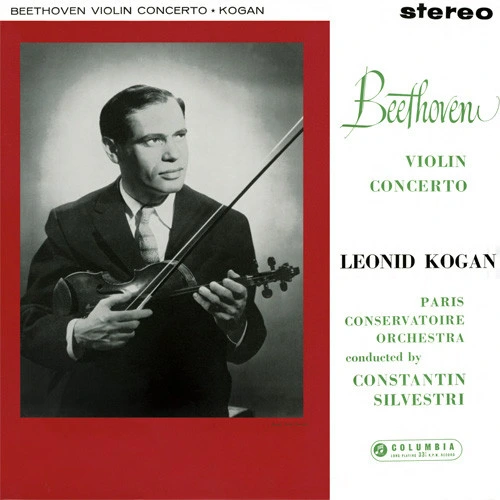Violinist David Oistrakh is joined by the French National Radio Orchestra conducted by Andre Cluytens for this recording of Beethoven's Violin Concerto in D Major.
"1806 was the year after the composition of Fidelio, the year of its first revision, and the year in which Beethoven wrote three sunny masterpieces, the serenest and most loving of which is certainly this violin concerto. He dedicated it, not to the co-operative lady friend of the movement, but to his boyhood friend Stephan von Breuning, a character who emerges more finely from the tale of Beethoven's life than any of his other friends.
"The concerto was written for Franz Clement who, at 26, was conductor and leader (two more or less synonymous posts, since baton-waving was not invented) of the famous Theater an der Wien. The concerto was written quickly, but only just completed in time for the first performance on 23 December; Clement is said to have sight-read his part, but this is not too stunning a feat, since he had been advising Beethoven on the layout of the solo, and may even have influenced the nature of the Rondo theme. At the premiere Clement played the new work in two parts, the Larghetto being preceded by an interval and a group of solos - one of these was a sonata for one-stringed fiddle played upside down. Czerny was mightily impressed by Clement's performance, but the concerto was thought insignificant until Joseph Joachim popularized it later in the century. Concert-goers of a past generation speak with reverent phrases of his interpretation, and claim it has never been equaled since; for younger folk the Beethoven violin concerto means Fritz Kreisler, and it is curious that he excelled in just those passages singled out by Joachim's eulogists, the G minor passage in the middle of the first movement, and the deathly hushed second tune of the Larghetto.
"Both these great players have left fine sets of cadenzas to the concerto. David Oistrakh plays those by Kreisler on the present record. The cadenzas by Beethoven to the concerto were designed for the adaptation as a piano concerto which he made in 1807, and dedicated to von Breuning's wife. The first movement cadenza was scored for piano and obbligato drums - it has been transcribed in our own time for violin and drums by Max Rostal." - from liner notes by William Mann
"David Oistrakh's strong, aristocratic reading on HMV Concert Classics is a fine one. The EMI recording is undoubtedly superior, with a spacious acoustic and warm, resonant orchestral tone. The reading is characteristically assured, the soloists's phrasing and sense of line impeccable." Penguin Record Guide.
Musicians:
David Oistrakh, violin
French National Radio Orchestra
Andre Cluytens, conductor
Selections:
Ludwig van Beethoven
Violin Concerto in D Major, Op. 61
1. Allegro ma non troppo - Cadenza - Tempo I
2. Larghetto
3. Rondo (Allegro - Cadenza) Tempo I
"1806 was the year after the composition of Fidelio, the year of its first revision, and the year in which Beethoven wrote three sunny masterpieces, the serenest and most loving of which is certainly this violin concerto. He dedicated it, not to the co-operative lady friend of the movement, but to his boyhood friend Stephan von Breuning, a character who emerges more finely from the tale of Beethoven's life than any of his other friends.
"The concerto was written for Franz Clement who, at 26, was conductor and leader (two more or less synonymous posts, since baton-waving was not invented) of the famous Theater an der Wien. The concerto was written quickly, but only just completed in time for the first performance on 23 December; Clement is said to have sight-read his part, but this is not too stunning a feat, since he had been advising Beethoven on the layout of the solo, and may even have influenced the nature of the Rondo theme. At the premiere Clement played the new work in two parts, the Larghetto being preceded by an interval and a group of solos - one of these was a sonata for one-stringed fiddle played upside down. Czerny was mightily impressed by Clement's performance, but the concerto was thought insignificant until Joseph Joachim popularized it later in the century. Concert-goers of a past generation speak with reverent phrases of his interpretation, and claim it has never been equaled since; for younger folk the Beethoven violin concerto means Fritz Kreisler, and it is curious that he excelled in just those passages singled out by Joachim's eulogists, the G minor passage in the middle of the first movement, and the deathly hushed second tune of the Larghetto.
"Both these great players have left fine sets of cadenzas to the concerto. David Oistrakh plays those by Kreisler on the present record. The cadenzas by Beethoven to the concerto were designed for the adaptation as a piano concerto which he made in 1807, and dedicated to von Breuning's wife. The first movement cadenza was scored for piano and obbligato drums - it has been transcribed in our own time for violin and drums by Max Rostal." - from liner notes by William Mann
"David Oistrakh's strong, aristocratic reading on HMV Concert Classics is a fine one. The EMI recording is undoubtedly superior, with a spacious acoustic and warm, resonant orchestral tone. The reading is characteristically assured, the soloists's phrasing and sense of line impeccable." Penguin Record Guide.
Musicians:
David Oistrakh, violin
French National Radio Orchestra
Andre Cluytens, conductor
Selections:
Ludwig van Beethoven
Violin Concerto in D Major, Op. 61
1. Allegro ma non troppo - Cadenza - Tempo I
2. Larghetto
3. Rondo (Allegro - Cadenza) Tempo I



 Turntable Accessories
Turntable Accessories Headphone Accessories
Headphone Accessories Cable Accessories
Cable Accessories Vinyl Accessories
Vinyl Accessories Compact Disc Accessories
Compact Disc Accessories









